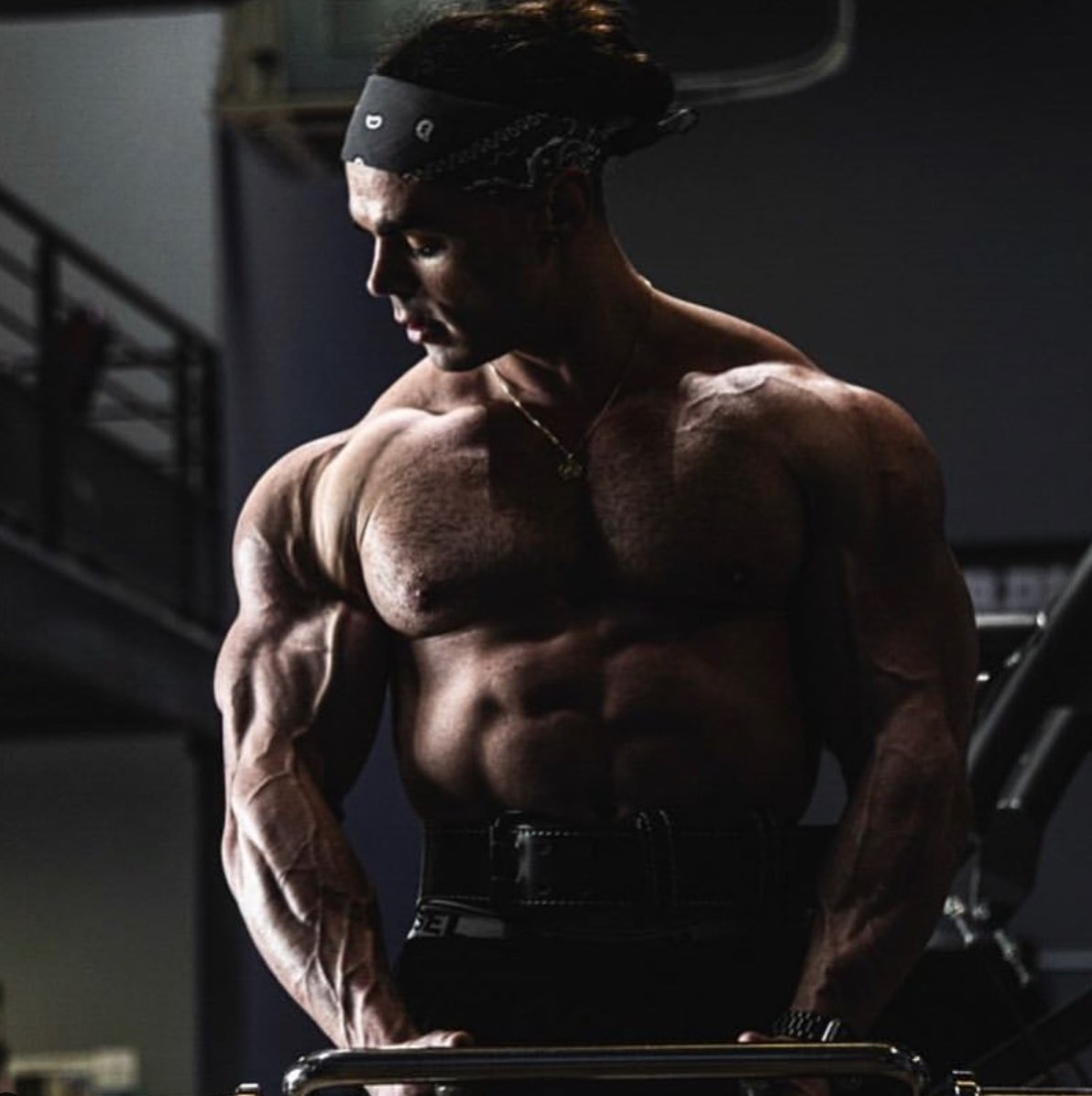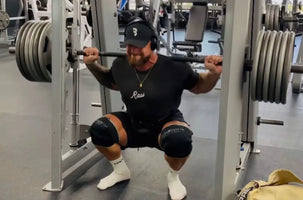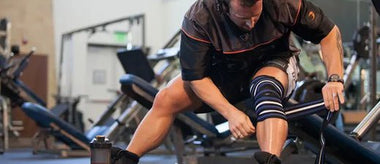
Muscle Pump 101 - How Long Does a Pump Last?
You get in the gym, you have a good workout session, you get a good pronounced pump and check out your guns in the mirror and you have noticeably bigger muscles. It's perhaps the greatest feeling you can get. Unfortunately for us, it won't last. It's a temporary increase in mass where they appear to be larger and more defined due to increased blood flow and swelling. It is a common goal for bodybuilders and fitness enthusiasts who want to achieve a more aesthetic appearance. However, the question remains, how long does a muscle pump last? How can I make it last longer?
According to various sources, the longevity of a gym pump is between 2-3 hours after a workout. The duration may vary depending on several factors, such as the intensity of the workout, personal anatomy, and nutrition. A high-intensity workout with heavier weights and rigorous exercises will lead to a more defined pump than a lighter session.
Whilst they may be a temporary effect, there are ways to prolong it. Certain supplements, such as nitric oxide boosters, may increase your pump duration. Additionally, maintaining a balanced diet and staying hydrated can also contribute to a longer-lasting pump. Understanding the factors that affect the duration can help individuals optimize their workouts and achieve their desired results.
Understanding Post Workout Pumps
During exercise, the body requires more oxygen and nutrients to fuel the muscles. Blood flow to the muscles increases to meet this demand, causing the muscles to swell and become engorged with blood. This also helps to remove waste products from the muscles, such as lactic acid, which can cause fatigue and soreness.
Also known as a transient hypertrophy, which means that it is a temporary increase in size that lasts for a few hours after exercise. It is not the same as permanent muscle growth, which is the result of long-term strength training and muscle hypertrophy.
The life of your pump and muscle mass after an intense workout depends on the intensity of the workout, the type of exercises performed, and the individual's fitness level. On average, the pump can last between 2 to 3 hours after the workout.
How Long Does a Pump Last After A Workout Session?
A temporary increase in muscle mass after a workout caused by extra blood and cell swelling due to muscle contraction and burning carbs during exercise. The duration varies from person to person and depends on several factors, including the intensity and length of the exercise.
A high-intensity workout with heavier weights and rigorous exercises will lead to a more defined pump than a lighter session.
To prolong it, there are several tips and tricks that one can follow. These include:
- Isolation exercises: Focusing on isolation exercises for sets of 8-12 reps with short rest periods
- Staying hydrated: Drinking plenty of water before, during, and after exercise can help maintain blood volume and prolong it
- Eating carbohydrates: Consuming more carbohydrates before and after exercise can help increase glycogen stores, which can help maintain it
- Skipping the cold tub: Avoiding cold water after exercise can help maintain blood flow to your muscles and prolong the muscle pump.
It is important to note that the duration is not indicative of growth or strength gains. Whilst it's a satisfying feeling you can get, a good pump doesn't last, it is a temporary phenomenon that does not necessarily reflect long-term progress.

Influencing Factors - How To Make A Gym Pump Last Longer
Several factors can influence the duration and intensity. Understanding these factors can help individuals optimize their workout routines to achieve their muscle pump goals.
Training Variables
- Reps and Weight: Performing high reps with light weights can increase blood to the muscles, leading to a more significant pump. However, lifting heavier weights with fewer reps can also create tension and demand on the muscles, leading to bulging guns.
- Form and Technique: Proper form and technique during exercises can help target the working muscles and create more tension.
- Volume and Intensity: Increasing the volume and intensity of a workout can create more demand on the muscles, lead you to achieve a pump. However, overtraining can lead to fatigue and a decrease in intensity.
- Rest Periods: Shorter rest periods between can create a more significant pump. However, longer rest periods can allow for more recovery and better performance during the next set.
- Isolation vs. Compound Exercises: Isolation exercises can target specific muscles and create a pump in those areas. However, compound exercises can create a more significant demand on multiple muscle groups, leading to an overall increased pump.
Other Factors
- Lactic Acid: Lactic acid buildup in the muscles during exercise can increase it.
- Stress and Temperature: Stress and high temperatures also have a better effect.
- Blood Flow Restriction Training: This can increase metabolic stress.
- Rep Range and Contractions: Varying rep ranges and using different types of muscle contractions (e.g., eccentric, concentric, isometric).
- Aesthetic Goals: Individuals with aesthetic goals may focus more on creating a pump in specific muscle groups to enhance their appearance.
- Bench Press and Bicep Curl: Certain exercises, such as the bench press and bicep curl, can create a more significant pump in specific groups.
- Demand and Power: Creating a high demand on the muscles and generating power during exercise can lead to a an increase.
- Movement and Tension: Focusing on slow, controlled movements and creating tension in the muscles.
- Sets and Repetitions: As long as you're mixing up number of sets and repetitions can create different types of pumps. Drop sets, for example, can increase it by increasing metabolic stress and make the muscle pump last longer.
Role of Nutrition, Gaining Muscle & Post-Workout Pump
Nutrition plays a crucial role. Proper hydration and nutrient intake can increase the duration and intensity of a muscle pump. Here are some key nutrients and dietary factors that can affect it:
Hydration
Muscles need water to function properly. Dehydration can cause muscle fatigue and reduce the duration and intensity . Drinking enough water throughout the day can help maintain proper hydration levels and improve it.
Carbohydrates
Carbohydrates are the primary source of energy for muscles. Consuming complex carbohydrates before training can help provide sustained energy during your session and improve muscle pump. Carbs help replenish glycogen stores in muscles, which can increase muscle size and vascularity.
Protein
Protein is essential for muscle repair and growth. Consuming protein after training can help stimulate protein synthesis. A protein shake or a meal containing lean protein can help provide the necessary amino acids for muscle repair and growth.
Nutrient Timing
Timing of nutrient intake can also have an effect. Consuming carbohydrates and protein within 30 minutes after a session can help replenish glycogen stores and stimulate protein synthesis, respectively. This can improve your pump and aid in muscle recovery.
Fluids
In addition to water, other fluids such as sports drinks play a role. Sports drinks contain electrolytes that can help maintain proper hydration levels and improve muscle function. However, it is important to choose a sports drink with low sugar content to avoid excess calorie intake.

Supplements For Getting A Pump In the Gym
Many athletes and bodybuilders use supplements to enhance their muscle pump during your training. These supplements work by increasing flow and improving nutrient delivery to the muscles. Here are some popular supplements:
Nitric Oxide Boosters
Nitric oxide (NO) is a molecule that plays a key role in regulating blood flow and oxygen delivery to the muscles. NO boosters, such as citrulline and L-arginine, are popular supplements for enhancement. These supplements work by increasing NO production in the body, which in turn increases flow and nutrient delivery to the muscles.
Pre-Workout Supplements
Pre-workout supplements are designed to provide a boost of energy and focus before you hit the gym. Many pre-workout supplements also contain ingredients that enhance muscle pump, such as creatine, beta-alanine, and caffeine. These supplements work by increasing blood flow and nutrient delivery to the muscles, which can lead to a more intense and effective session.
Creatine
Creatine is a popular supplement for improving muscle performance and recovery. It works by increasing ATP production in the muscles, which can improve muscle endurance and strength. Creatine has also been shown to have a positive effect.
Muscle Pumping Supplements
There are a variety of supplements on the market that are specifically designed to help. These supplements typically contain a combination of ingredients, such as nitric oxide boosters, creatine, and caffeine. While some of these supplements may be effective, it is important to do your research and choose a reputable brand.
Muscle Pump and Muscle Growth
A temporary increase in size and vascularity that occurs during and immediately after exercise. The pump is caused by increased flow to the muscles, which delivers oxygen and nutrients while removing waste products. Whilst temporary phenomenon, it may have implications for growth and hypertrophy.
Hypertrophy, is the process by which muscles increase in size. This can occur through two mechanisms: an increase in the size of individual muscle fibers ( hypertrophy) or an increase in the number of fibers (fiber hyperplasia). Although it does not directly cause growth, it may be a sign that the muscle is being stimulated in a way that could lead to growth.
Research has shown that muscle size and pump are not always directly related. While it may cause temporary increases in muscle size, it does not necessarily lead to long-term growth. However, it can be an indicator that the muscle is being stimulated in a way that could lead to growth.
Muscle hypertrophy occurs when the muscle is exposed to a stimulus that exceeds its current capacity. This stimulus can be provided through resistance training, which causes muscle damage and inflammation. The body responds to this stimulus by repairing and rebuilding the muscle tissue, leading to gain more muscle size and strength over time.
In order to maximize muscle hypertrophy, it is important to use a variety of exercises and training techniques. This can include using heavy weights with low reps to target type II fibers, as well as using lighter weights with high reps to target type I fibers. Additionally, proper nutrition and recovery are essential, as the body requires adequate protein and rest to repair and rebuild muscle tissue.
Exercise Techniques To Stay Pumped After A Workout
Achieving a good pump during a workout is often considered a badge of honor among fitness enthusiasts and athletes alike. Here are some of the best tips to last longer:
Progressive Overload
Progressive overload is the gradual increase of stress placed on the body during exercise. This can be achieved by increasing the weight lifted, the number of repetitions performed, or the number of sets completed. By gradually increasing the workload, the body is forced to adapt and grow stronger. This can lead to larger pumps as the muscles are challenged with heavier weights.
Supersets
Supersets involve performing two exercises back-to-back with little to no rest in between. This can help increase the intensity and lead to a greater pump. For example, performing bicep curls immediately followed by tricep extensions can enhance it in both groups.
Isolation Exercises
Isolation exercises target a specific group of muscles. Examples of isolation exercises include leg extensions for the quadriceps and bicep curls for the biceps.
Stretching
Stretching can lead to a better results during a workout. It is important to stretch both before and after to prevent injury and improve recovery.
Absorb Your Workout
Staying focused and mentally present can help improve the mind-muscle connection. This ensures the muscles are engaged and worked to their fullest potential.
Short Rest Periods
Short rest periods between sets can help increase the intensity. This is because the muscles are not given enough time to fully recover before being worked again.
Endurance Training
Endurance training can help improve cardiovascular health and increase flow to the muscles. Examples of endurance training include running, cycling, and swimming.
Compound Exercises
Compound exercises involve multiple groups and can help increase overall muscle mass. This can lead to a larger pump as more muscles are being worked. Examples of compound exercises include squats, bench presses, and pull-ups.

Recovery and Ensuring Muscles Stay Pumped
After an intense workout, you may feel sore and fatigued. Give your muscles a break to help the body repair and rebuild for optimum muscle development . During this process, the pump may gradually diminish.
One way to aid in recovery and maintain it is to focus on proper nutrition. Consuming a balanced diet with adequate protein, carbohydrates, and healthy fats can help support growth and repair. Additionally, staying hydrated can help maintain blood volume and aid in nutrient delivery to the muscles.
Bodybuilders often use various techniques to aid in recovery and prolong it. One popular method is utilizing a cold tub or ice bath. This technique involves immersing the body in cold water to reduce inflammation and promote muscle recovery. However, it is important to note that this method may not be suitable for everyone and should be used with caution.
Another factor considering recovery is cortisol levels. Cortisol is a hormone released during times of stress, and high levels of cortisol can lead to muscle breakdown and hinder recovery. Therefore, it is important to manage stress levels through techniques such as meditation, deep breathing, and adequate rest.
Duration of a Gym Pump and Cardio
Cardio exercises, such as running or cycling, can affect the duration. When performing cardio, the heart rate increases, and blood is pumped to the muscles at a faster rate. This increased flow can help it last a little longer.
However, it is important to note that performing cardio exercises before weightlifting can lead to a decrease. This is because the body has already used up some of the glycogen stores needed to fuel the muscles during weightlifting. As a result, there may be less flow to the muscles and therefore a shorter duration.
On the other hand, performing cardio exercises after weightlifting can help to sustain it. This is because the muscles have already been worked, and there is an increased flow to the muscles. Additionally, performing cardio exercises after weightlifting can help to flush out lactic acid, which can contribute to muscle soreness.
What Does The Pump Mean for Aesthetic Appeal
This aesthetic appeal is a major motivating factor for many fitness enthusiasts.
When a muscle is worked, it undergoes micro-tears which result in inflammation. The body responds to this by increasing blood flow to the affected area, which makes your muscles swell and appear larger.
The aesthetic appeal is not just limited to the visual aspect, it also provides a sense of accomplishment and satisfaction. The feeling of tightness and fullness in the muscle is a sign of a good workout. It also helps in maintaining motivation for future sessions.
Time under tension is an important factor. It refers to how long your muscles are under stress during training. Higher time under tension leads to greater muscle damage and inflammation, which in turn leads to a more defined pump and continuous muscle growth .
Post-workout nutrition also plays a crucial role. Consuming protein and carbohydrates afterwards helps in repairing and rebuilding muscle tissue, which leads to an anabolic response. This response enhances growth and helps in achieving a better pump.

Gym Accessories For The Best Pump Long After a Workout
There are a few gym accessories that can be used. Here are some popular ones:
1. Blood Flow Restriction Bands
These restriction bands are designed to restrict flow to the muscle being worked. These bands are typically worn around the upper arm or thigh during exercise. It is essential to use them correctly to avoid injury.
2. Pre-Workout Supplements
These supplements typically contain ingredients such as caffeine, nitric oxide, citrulline malate and target the muscle cells
3. Compression Clothing
Compression clothing can help improve the pump you get. These clothing items are designed to fit tightly around the muscles being worked. Check out our range of apparel.
4. Electro-Stimulation Devices
Electro-stimulation devices can ensure you get better results. These devices use electrical impulses to stimulate the muscles being worked.
5. Heat Wraps
Heat wraps can help increase blood flow to the muscles. These wraps are typically worn around the muscle being worked and can help increase the temperature of the muscle.
FAQ's - How Long Does a Gym Pump Last
How long can you maintain a longer-lasting gym pump?
We know how long it lasts, it's around 2-3 hours after your workout depending on the type of workout. However, how long your pump you're lasts can vary based on factors such as the individual's fitness level and the intensity.
What are some tips to make your pump last longer?
To prolong your muscle pump, try the following tips:
- Increase the number of reps and sets
- Shorten the rest periods between sets
- Use lighter weights and focus on form and technique
- Incorporate supersets or drop sets
- Stay hydrated before, during, and after exercise
What causes a pump to go away quickly?
Several factors can cause the muscle pump to last in both the short and long term, including:
- Dehydration
- Lack of proper nutrition
- Poor blood circulation
- Overtraining
- Insufficient rest between your training sessions
How can you get a good muscle pump during your workout?
Get in a gym and try the following:
- Focus on high-rep, low-weight exercises
- Use compound exercises that engage multiple muscle groups
- Incorporate supersets or drop sets
- Shorten the rest periods between sets
- Stay hydrated before, during, and after exercise
Is a pump an indicator of muscle growth?
Whilst not necessarily an indicator, it can be a sign that your muscles are getting enough blood and nutrients to promote future muscle growth. However, it is primarily dependent on progressive overload, proper nutrition, and sufficient rest.
What are some effective ways to maintain a pump throughout the day?
To maintain throughout the day, you can try the following:
- Stay hydrated by drinking plenty of water
- Eat a balanced diet that includes protein, carbohydrates, and healthy fats to keep your muscles nourished
- Incorporate cardiovascular exercise into your routine to improve blood circulation
- Avoid sitting or standing in one position for too long
- Consider using compression garments to improve blood flow and reduce muscle soreness.






